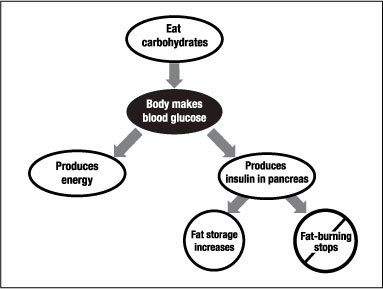The sun is out and our unbelievable record-setting Alaska winter snowfall is finally leaving. Soon we’ll be wearing shorts, bathing suits and, looking in the mirror, yikes! extra winter insulation has just got to go: time to lose some weight!
There is probably no bigger argument in the corporate lobbying dietician/nutrition world than how to get to our ideal weight. Should we count calories, percent of protein, percent of carbohydrate or glycemic index? Which is the most important weight loss strategy (or how can we prevent diabetes, lower cholesterol, improve heart health…) And, of course, we have to shun dietary fat—which corporate lobbying “everyone knows” is bad (another article on that at another time). Truthfully, 30 years of well-done research is being smothered in corporate lobbying confusion.
The correct answer to successful weight control may just be: none of the above—it’s the type of starch that matters.
Decades of very well done research show that the worst food for your waistline (and your heart) is (the envelope please) wheat. (yes, even whole wheat). What type of starch you eat could well be the most important factor in you and your family’s ability to maintain an ideal weight.
First of all, some definitions:
Calories n. the amount of energy produced by food when used in the body.
The common, simple math, view of lose weight by eating fewer calories than what you use for energy is why many people are over fat.
Quantity sort of counts, quality is what’s important!
Carbohydrates n. a class of food including sugars, starches, and celluloses that produce quick energy. Net Carbs that are not quickly burned as energy are converted and stored as fat. ALL fruits, legumes, cereal grains, other seeds, nuts, and vegetables contain various forms of carbohydrates. Not all carbohydrates are created equal:
Starch is made up of units of a sugar, called glucose, chemically linked together. Depending on the starch source and processing, these glucose units may be very tightly linked or they may be weakly linked together. For this reason, different starches are digested at different rates.
In other words: not all carbohydrates are created equal! Work by Dr. Kay Behall and colleagues (American Journal of Clinical Nutrition) shows how the form of starch now prevalent in all our engineered wheat (starting with crossbreeding programs in the 1960’s) actually causes blood sugar imbalances, weight gain, and cholesterol problems. Although more recent engineering involves adding genes that do not belong in plants—genes causing these plants to make chemicals that are pesticides or help resist weed killers—crossbreeding to increase starch (or size, or color or anything) is a form of engineering. Just like forcing plants to make pesticides, forcing plants to make more starch/sugar or ripen slowly on the truck is not necessarily the best thing for your health.
The wheat we eat today is not the same wheat as yesteryear. Sorry dear reader: marketing campaigns of yesteryear promoting lighter, moister, cakes (and breads and muffins and sugar cookies…) were aimed to increase use of wheat engineered to produce the lightest, fluffiest, baked goods possible—and most inexpensively. Today’s wheat was selected to have the highest amylopectin content (a form of starch) so more refined foods could be produced per acre.
Common cereal grains, corn, rice, and oats, approach 100 percent amylopectin thanks to crossbreeding while the starch found in barley, along with legumes, is only partially amylopectin. Legumes and “pseudo-grains” are far lower in amylopectin. Could this matter to our health? YES!
During a decades-long career, Dr. Behall answers the question we forget to ask: “how does this affect my health?” (especially weight, diabetes, cardiac health and cholesterol).
 The starch form of carbohydrates are long chains of sugar. When we eat starchy foods, such as bread and pasta, cakes and cookies, the small intestine breaks these down into glucose, a simple sugar that serves as your body’s main source of fuel. When glucose is absorbed through the intestine, blood glucose levels rise. Because high blood sugar is toxic
The starch form of carbohydrates are long chains of sugar. When we eat starchy foods, such as bread and pasta, cakes and cookies, the small intestine breaks these down into glucose, a simple sugar that serves as your body’s main source of fuel. When glucose is absorbed through the intestine, blood glucose levels rise. Because high blood sugar is toxic, your pancreas makes insulin that removes sugar from the blood and sends it into every cell in your body.
But different types of cells can accept different amounts of sugar. In fact, fat cells can continue to absorb blood sugar after other cells like liver and muscle have reached their limit and become temporarily resistant to insulin.
Once inside the cell, the glucose is either used as short-term energy (the exercise you do right after eating) or it is converted to fat and stored. Although muscle cells burn glucose to make energy, the typical person—even an athletic person—is not the sort of athlete that burns that much carbohydrate. Fat cells, on the other hand, convert glucose to triglycerides and store the triglycerides for later use (or leak them into our blood stream when they become over-full, raising our blood triglycerides).
Fat cells, also called adipose cells, have a higher capacity to receive sugar from the blood stream than any other type of cell in the body. Their job is to store it as fat.
In other words, if you are eating high amounts of starchy foods you are creating a blood sugar spike that is ultimately stored as fat in your fat cells.
And… the type of starch most prevalent in modern cereal grains (wheat, corn and rice) does this more effectively than the heirloom and non-engineered variants as well as more effectively than legumes or starchy root vegetables.
Why is the type of starch important? Dr. Behall’s findings show that amylopectin, the specific starch found in high amounts in wheat (and many other cereal grains), causes a higher insulin spike than food containing other starches (for those of you who like to know the exact name, this study compared amylopectin with the other common starch amylose. Interesting tidbit: it was amylose that was engineered out of wheat, rice and corn).
And… in a one-two punch, the type of starch in modern cereal grains also suppresses our fat-burning hormone: glucagon.
While insulin works to move blood sugar into cells and signals cells to store fat and nutrients, glucagon works oppositely. Glucagon is the hormone made when blood sugar levels drop below a certain point. It launches a cascade of events to prevent low blood sugar and burn fat for energy. If you want to lose weight (burn fat), you MUST NOT eat carbs between meals and you must limit their intake severely during meals. You MUST force your body to release and burn its fat stores.
This same study shows that in these healthy volunteers, not only did amylopectin (in cereal grains) result in an insulin spike, but it also resulted in much lower levels of glucagon production for up to four hours after each meal (just in time for the next meal in a fat accumulating cycle).
No only that, but in another study, Dr. Behall also shows how reducing the type of starch found in modern cereal grains also reduces blood triglyceride levels in both healthy and pre-diabetic individuals.
If you want to control your weight, cholesterol, blood sugar and heart health, replace wheat, corn, and rice grains with less starchy carbohydrates such as root vegetables and eat unlimited amounts of green leafy vegetables.
And a few more helpful definitions:
Grains n. seeds from the cereal grasses (Poaceae, also called Gramineous, family). These include: Barley, Corn, Millet, Oats, Rice (any color) Rye, Sorghum (also called milo), Teff, Triticale, Wheat, (including varieties such as spelt, emmer, farro, einkorn, Kamut®, durum and wheat forms such as bulgur, cracked wheat and wheatberries) Wild rice.
Whole grains (In May 2004, the Whole Grains Council endorsed this definition): whole grains or foods made from them must contain all the essential parts and naturally-occurring nutrients of the entire grain seed. If the grain has been processed (e.g., cracked, crushed, rolled, extruded, and/or cooked), the food product should deliver approximately the same rich balance of nutrients that are found in the original grain seed.
This definition means that 100% of the original kernel – all of the bran, germ, and endosperm – must be present to qualify as a whole grain.
For years now we’ve found that non-cereal “pseudo-grains” like buckwheat test better using Nutrition Response Testing. Wild and some heritage rices, such as forbidden rice and wehani rice work well if they are properly prepared.
Although we are not in the clinical trials business, we definitely observe that our patients who follow our clinical nutrition recommendations lose weight. Our combination of individualized nutrient and dietary recommendations allows slow and stable weight loss with improved overall health.
Try my recipes for quick breads, even muffins and get back to eating the way our bodies were designed.
Copyright © 2013. Marie Sternquist. All Rights Reserved.







Pingback: Fuel for Athletic Performance: natural sports drink power. | Our Nutrition Kitchen
Pingback: HCG Diet – Weight Loss Miracle? Diet Scam? | Our Nutrition Kitchen